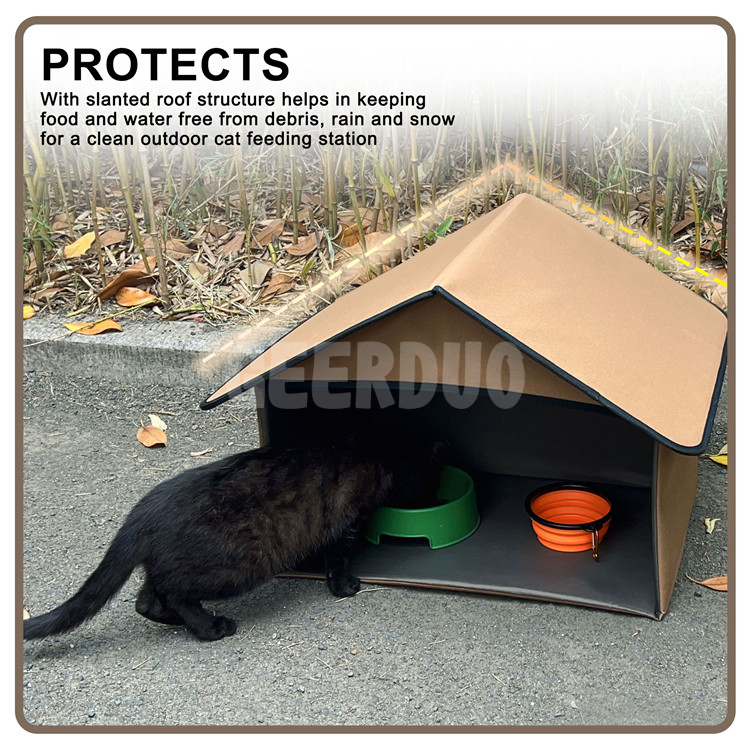- All
- Product Name
- Product Keyword
- Product Model
- Product Summary
- Product Description
- Multi Field Search
GRDDC-17
GEERDUO
19.7*13.8*16.7inch
600D Oxford
4.37lb
PP Bag
| Availability: | |
|---|---|
| Quantity: | |
Product Description





Insulated Construction: Stray cat shelters often have insulated walls and floors to provide warmth and protection from cold temperatures. Insulation helps to retain heat inside the shelter, keeping the cats cozy during colder seasons.
Weatherproof Materials: The shelters are typically made from weatherproof materials, such as durable plastic or wood with weather-resistant coatings. These materials prevent water from entering the shelter and protect the cats from rain, snow, and wind.
Ventilation: Good airflow is crucial in stray cat shelters to prevent condensation and maintain a comfortable temperature. Shelters may include ventilation holes or raised floors to allow fresh air to circulate while keeping moisture and drafts out.
Entrance Shield: To further protect the cats from the elements, shelters often have an entrance shield or a flap that acts as a door. This shield helps to block wind, rain, and snow from entering the shelter, creating a more secure and comfortable space.
Raised Platform: Some shelters feature a raised platform or floor to elevate the cats off the ground. This helps to prevent moisture and cold from seeping through the bottom of the shelter, providing additional insulation and protection.
Easy Access: Stray cat shelters may have multiple entrances or openings to allow cats to enter and exit easily. These entrances provide escape routes in case of emergencies and ensure that the cats feel secure inside the shelter.
Cozy Bedding: Providing soft and comfortable bedding inside the shelter is essential for the cats' comfort. This can include straw, blankets, or specially designed cat beds that retain warmth and provide a cozy sleeping surface.
Predator Protection: Some shelters have additional features to protect the cats from predators. This may include raised or covered entrances to deter larger animals from entering or mesh screens to prevent unwanted access.
Easy to Clean: Stray cat shelters should be easy to clean to maintain a hygienic environment. They may have removable roofs or sections that allow for convenient cleaning, disinfecting, and removing any accumulated debris.
Sturdy and Secure Design: Stray cat shelters are designed to be sturdy and secure, providing a safe haven for the cats. They should be able to withstand outdoor conditions and resist damage from potential impacts or attempts to access the shelter.
Manufactures and wholesalers
We are manufacturing factory which has 15 years experience in making bags, we have our own design team to design multi product models for your choice, For popular items we make stocks which are ready to ship anytime and any quantity, We also release new products frequently.
Professional OEM/ODM Service/low MOQ
We welcome both OEM and ODM orders. We could put your logo on our hot-sale model or help you to manufacture the product according to your design. Our MOQ is 200 pcs.
Excellent Customer Service
If you have any question about the products, delivery, or shipment, we have good customer service that ensures your concerns will be responded in time. Also we have rich experience in exporting, We can communicate through the live chat, email or contact form on the website. Our customer service will try best to offer you our honest and professional help and solution.
Fast Delivery and Strict Quality Control
If you order our stock product, we will ship the products out within 2-3 working days.
If you place your customized order, we will confirm the sample with you before bulk production and update you the production situation during the whole production process. We will also send you the images of our finished products and packaging.
We have our quality control team who will do strict quality inspection for every order. We fully think quality is the most important for long-term cooperation and quality is our culture.
Contact us, you will get a sincere and professional partner!
Packing Information
| Packing Information |
| NO. | GRDDC-17 |
| Packing Size | 19.7*14.6*1.4 inches |
| CTN Size | 4.37 Pounds |


Shipping and Payment
 | Shipping & Payment |
| MOQ | 200pcs |
| Sample Leading Time | 5-7days |
| Bulk Leading Time | 40 days after deposit payment |
| Payment Terms | T/T 30% deposit and balance before shipping |
| Port | Shanghai Port |
| Shipping Method | By sea/air/express |

For large quantity, we suggest shipping by sea.
For small quantity, air express is our preferred shipping method.
We support shipment by "HK post" "China post" "EMS" "DHL" "UPS" "FEDEX" "TNT" .
If you need help selecting a fast and reliable shipping company, please contact us direct and we will do our best to help.
FAQ
A stray cat shelter is a designated area or structure that provides a safe and protected space for stray cats to seek refuge and find temporary shelter.
Important information:
Safety and security: Stray cat shelters are designed to provide a secure and protected environment for stray cats, shielding them from harsh weather conditions and potential dangers.
Temporary solution: These shelters are meant to offer temporary relief for stray cats while long-term solutions such as adoption or rehoming are pursued.
Community support: Stray cat shelters are often established through community initiatives or organizations dedicated to promoting the welfare of stray cats.
Stray cat shelters play a crucial role in improving the well-being of stray cats and addressing the challenges they face in the outdoor environment.
Important information:
Protection from the elements: Shelters provide a safe haven for stray cats, protecting them from extreme weather conditions, such as rain, snow, and heat.
Reduced risks: By offering a sheltered space, these shelters help minimize the risks of disease transmission, predation, and accidents that stray cats may encounter.
Improved chances of survival: Stray cat shelters increase the chances of survival for vulnerable cats, particularly during harsh seasons when food and water sources may be scarce.
Various types of shelters can be used to provide suitable housing for stray cats, depending on the resources available and the specific needs of the cats.
Important information:
Insulated shelters: Insulated shelters, made with materials such as foam or styrofoam, help provide warmth and insulation during colder months.
DIY options: There are numerous DIY shelter designs available, including using storage containers, wooden structures, or repurposed materials, which can be customized to fit specific locations and cat populations.
Pre-made cat shelters: Some companies offer pre-made cat shelters designed specifically for outdoor use, often featuring insulation, weatherproof materials, and easy assembly.
Proper placement of stray cat shelters is essential to ensure their effectiveness and the safety of the cats utilizing them.
Important information:
Safe and secluded areas: Shelters should be placed in quiet, low-traffic locations away from potential hazards, such as busy roads or areas frequented by predators.
Elevated positions: Raising the shelters off the ground on a platform or pallet helps prevent flooding and provides an added layer of insulation.
Strategic orientation: Positioning the shelter to face away from prevailing winds and providing adequate ventilation can help create a comfortable environment for the cats.
Incorporating feeding and watering solutions within stray cat shelters can help ensure that the cats have access to nourishment and hydration.
Important information:
Feeding stations: Place food and water bowls inside or near the shelter, ideally in a separate section to keep them clean and protected from the elements.
Regular maintenance: Check and replenish food and water regularly, removing any uneaten or spoiled food to maintain hygiene and prevent attracting pests.
Consider automatic feeders: Automatic feeders can be a useful option for providing regular, timed meals to the cats, especially if caretakers may not be available every day.
Encouraging stray cats to use the shelter involves creating a welcoming and inviting space for them.
Important information:
Placement of familiar items: Use bedding or materials with scents familiar to cats, such as straw or blankets, to make the shelter more appealing and comfortable.
Gradual acclimation: Introduce the shelter gradually by placing food and water nearby, allowing the cats to become familiar with the location and associating it with positive experiences.
Patience and persistence: Stray cats may take time to trust and use the shelter, so it's important to be patient and consistently provide a safe and inviting environment.
Yes, stray cat shelters can also be utilized for feral cats, as they offer a secure space for these cats to find shelter and protection.
Important information:
Feral cat behavior: Feral cats are typically more cautious and less accustomed to human interaction, so providing a quiet and undisturbed space is essential.
Trap-Neuter-Return (TNR) programs: Feral cats are often part of TNR programs, where they are trapped, spayed or neutered, and returned to their original location. Shelters can support these efforts by providing a safe space for cats before and after the TNR process.
Ongoing monitoring: Regularly check the shelter to ensure it remains in good condition and address any maintenance or cleanliness issues promptly.
It is important to familiarize yourself with local regulations and obtain any necessary permissions before establishing stray cat shelters.
Important information:
Local ordinances: Some areas may have specific regulations or permits required for setting up shelters for stray or feral cats. Research local laws or consult with local animal control or animal welfare organizations to ensure compliance.
Property ownership: If you plan to place shelters on private property, seek permission from the property owner and ensure the shelters do not violate any zoning or property use restrictions.
Collaboration with animal welfare organizations: Partnering with established animal welfare organizations or local rescue groups can provide guidance and support in navigating legal considerations and ensuring the shelters meet relevant requirements.
There are several ways to contribute to stray cat shelters and the welfare of stray cats in your community.
Important information:
Volunteer: Offer your time and skills to local animal welfare organizations or community initiatives involved in managing stray cat shelters, such as cleaning, maintenance, or fundraising.
Donation drives: Contribute to donation drives specifically organized to collect supplies and resources for stray cat shelters, including bedding, food, water bowls, and other essential items.
Spreading awareness: Advocate for the importance of stray cat shelters and educate others about responsible stray cat management, including spaying/neutering and TNR programs, to help reduce the stray cat population.
Stray cat overpopulation can be a significant challenge in many communities. Taking proactive steps can help manage and reduce the population over time.
Important information:
Spaying and neutering: Support and promote spaying/neutering programs to prevent the reproduction of stray cats, reducing the population growth.
TNR initiatives: Encourage and participate in Trap-Neuter-Return (TNR) programs, which involve trapping, sterilizing, and returning stray cats to their original location, effectively managing the population.
Collaboration with animal welfare organizations: Work with local animal welfare organizations, veterinarians, and community groups to implement comprehensive strategies for stray cat management, including education, sterilization programs, and the establishment of proper shelter and feeding stations.